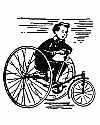|
|
|
8. A Veterinarian "Shoes"
a Horseless Carriage
A Radio Talk by Charles F. Kettering
Today we are surrounded by so many
highly developed products, such as the electric light, the radio, the
telephone and the automobile, that we are apt to forget how we came by
them. They are so interwoven into our daily lives that we
overlook their importance until something threatens to
deprive us of their use.
Take the automobile, for instance. Until now,
very few of us really appreciated how much the operation of cars,
buses and trucks depended upon gasoline and rubber tires. While our
thirty million pneumatic-tired vehicles today have the capacity to move
every man, woman and child in the United States at the same time, yet
there was not even a pneumatic bicycle tire on the market sixty
years ago.
 But, thanks to Charles Goodyear,
bicycles did have solid rubber tires. In Belfast, Ireland, in 1884,
some of the streets were paved with what we call Belgian block, not
exactly a smooth road for solid-tired bicycles. Every day, a small boy
rode his hard-tired tricycle over these blocks to school and
complained to his father about the roughness. His father, Doctor John Dunlop, a
veterinarian, decided to do
something about it. He made a wooden disc wheel, and around the edge of
it fastened an inflated rubber tube held in place with linen cloth
tacked to the wheel.
But, thanks to Charles Goodyear,
bicycles did have solid rubber tires. In Belfast, Ireland, in 1884,
some of the streets were paved with what we call Belgian block, not
exactly a smooth road for solid-tired bicycles. Every day, a small boy
rode his hard-tired tricycle over these blocks to school and
complained to his father about the roughness. His father, Doctor John Dunlop, a
veterinarian, decided to do
something about it. He made a wooden disc wheel, and around the edge of
it fastened an inflated rubber tube held in place with linen cloth
tacked to the wheel.
|
|


 But, thanks to
But, thanks to 





